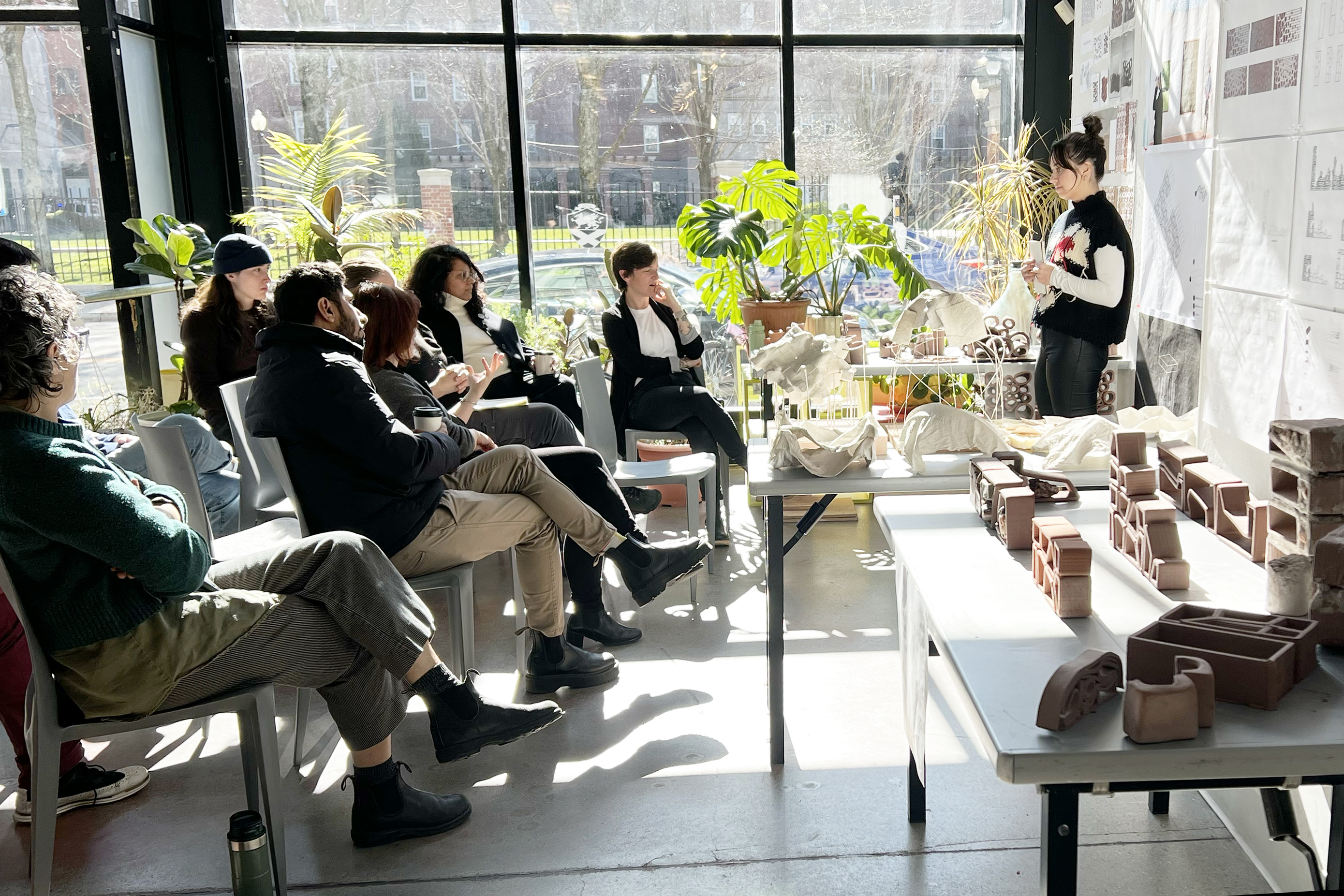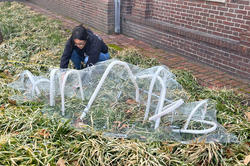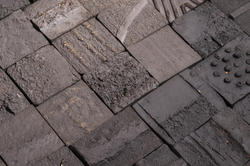Grad students Claudia Peck, Priyata Bosamia and Shivani Pinapotu gain hands-on experience working with museum staff.
RISD’s Sustainability Design Lab Fosters Low-Impact Design Strategies

How might the use of clay inform contemporary designers’ practices and shape considerations around sustainability? Interior Architecture and Landscape Architecture students enrolled in a course called Clay Matters are exploring this question in the second half of their yearlong engagement with RISD’s Sustainability Design Lab. Working with faculty members Tiago Campos, Eduardo Benamor Duarte and Lara Davis, the students are researching historical and modern-day uses of clay and investigating related applications like masonry design, brickmaking and earthen building.
Last fall, the students took a course called Material Explorations led by Landscape Architecture faculty member Nick De Pace BArch 95 and developed thesis statements, which they are continuing to test and shape via hands-on experimentation. They’re also responding to feedback from clay specialist (and RISD alum) Tamara Kaplan MAT 00 and other advisors reviewing each phase of the work. As noted in the spring course syllabus, “The process of design research—just like any research—requires re-evaluation, reiteration, reformulation and possibly redirection.” This semester’s work began with material investigations considering such parameters as geographical and cultural context, scale and sustainability.
Ashley Pedersen MLA 24 presented her research into repairing pavement at a midterm critique in March. Using Providence’s poorly maintained Cathedral Square as a point of reference, she set to work unifying the site’s design language by developing clay pavers to (theoretically) replace the existing hodgepodge of broken granite slabs, tiles and cobblestones.


“The strategy of repair restricts consumption and dramatically reduces the site’s overall carbon footprint,” Pedersen explained. “And repair can draw attention to the site and create a snowball effect for other interventions.”
Alice Zhang 24 IA/PT shared a modular system she is working on to create acoustic screens using 3D-printed clay blocks, wooden studs and a variety of recycled fabrics, including nylon and felt. The critics were taken by the beauty of her prototypes but expressed concern about whether or not fired clay elements would absorb sound as intended.
Jen Ansley MLA 24 showed 3D-printed and fired clay components they see as elements of dry-constructed exterior walls that could provide a container for existing brick rubble and provide outdoor seating. The project was inspired by their research into three New York sites in which clay bricks have historically been incorporated: one upstate in Kingston, one on the Lower East Side of Manhattan and a third in the South Bronx. “Clay has an ecologically important role to play in sustainable architecture,” Ansley said.
As the individual research projects continued, the class welcomed Italian earthen architecture specialist Maddalena Achenza for a two-day workshop. Engaging with experts whose work addresses sustainable design through the lenses of history, visualization, fine arts and the sciences is part of the Sustainability Design Lab’s mission. “Access to these experts is imperative for creating a global dialogue based on a wide range of views from outside our familiar disciplines and cultural norms,” says lab co-director and Landscape Architecture Department Head Johanna Barthmaier-Payne.


On Day 2 of the workshop, Achenza is demonstrating the technique she uses for mixing soil, water and straw to create a paste that can be applied to wooden frames (a process called wattle and daub). Such techniques have been used around the world for thousands of years—particularly in hot, humid climates—and there are countless buildings constructed with earthen walls today, even in areas where earthquakes are common.
“Straw has nice long fibers that are easy to work with,” Achenza says, her hands wrist-deep in the muddy mix, “but people also use barleycorn, rice, wheat—whatever they have close by.”
The students are working in pairs, sponging the frames with water, mixing the materials and applying them to the frames from the bottom up as instructed. Davis, who has led hands-on training programs on several continents, is experimenting with a related technique in which the mix is pounded into a wooden frame to create bricks. “I’m testing out different ratios,” Davis explains. “If it’s crumbly it means there’s too much sand in the soil. These bricks are great insulators, they’re resistant to flooding and fireproof,” she adds.
The experience will influence the students’ thesis projects, and the bricks and earthen panels they’ve been working on will be included in an exhibition slated for late May in RISD’s Sol Koffler Gallery. The goal of the show, like that of the Sustainability Design Lab itself, is to foster a clearer understanding of how low-impact design strategies can shape the future of the built environment and drive students to continually question and revise their own design decisions.
Simone Solondz / top image: work in progress by Jen Ansley
May 7, 2024


